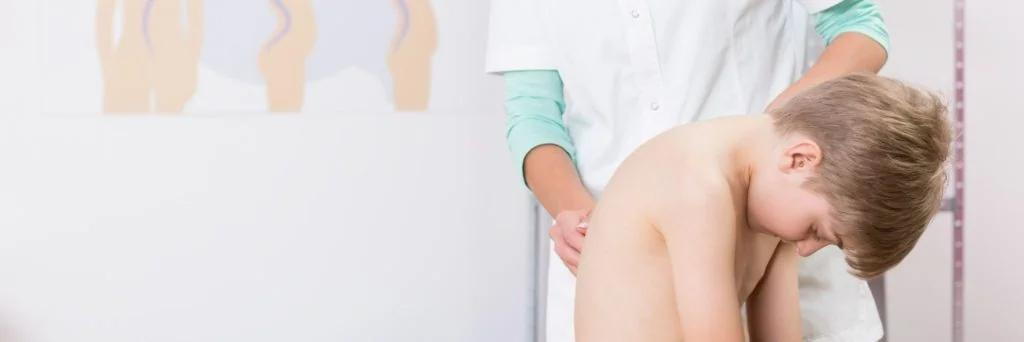
Can Chiropractic Care Treat Scoliosis?
- posted: Feb. 16, 2022
Scoliosis affects approximately 3% of children and 2% of adults. If left untreated, it can cause a wide range of challenges, from minor pain and discomfort to serious health problems such as back pain, headaches, fatigue, and even paralysis.
Generally, when people think of treatment for scoliosis, they imagine braces or invasive, surgical therapies. Of course, those are available and sometimes necessary, but other treatment options, including chiropractic care, exist.
What is Scoliosis?
Scoliosis is a condition in which the spine curves abnormally. Our spines are meant to curve forward and backward, but there’s a sideways curvature for those with scoliosis. That abnormal spinal curvature can be in the thoracic, cervical, or lumbar spine and is typically diagnosed when the curve is greater than 15 degrees.
The various types of scoliosis have different causes. For example, congenital scoliosis results from maldevelopment of the vertebrae in utero; neuromuscular scoliosis is often the result of greater neuromuscular conditions like cerebral palsy and muscular dystrophy; degenerative scoliosis, usually found in adults, is a product of the same processes that cause degenerative disc disease or osteoarthritis. These types of scoliosis may not benefit from chiropractic care. Fortunately, idiopathic scoliosis (the most common form) can benefit from chiropractic treatment.
What are some of the signs and symptoms?
In addition to noticeable, visible curvature, some of the signs and symptoms of scoliosis can be general aches & pains and decreased range of motion. For example, you may notice that a shoulder blade bulges or that your shoulder blades are uneven. That can indicate scoliosis, too.
If you’re concerned that you may be suffering from the condition, reach out to any medical provider that deals with the musculoskeletal system (your primary care physician, chiropractor, physical therapist, massage therapist, etc.) for a diagnosis. It’s generally evident and easy to identify via Adam’s test (where you are asked to stand in front of the provider and, while facing away from them, bend forward so they can see your spine as you move).
Is scoliosis treatable?
Yes! It can be treated and managed, though it’s never completely cured. Treatment varies depending on scoliosis’s type and severity (how significant the spinal curvature is). It ranges from invasive, surgical treatment (like Harrington rods) to at-home physical therapy exercises.
We have the most success treating idiopathic scoliosis as far as chiropractic care. The goal of treatment is to get the patient to a point where they are not feeling pain or discomfort from scoliosis, and the condition isn’t worsening or causing additional problems.
Treatment is unique to each patient but generally relies on a combination of chiropractic adjustments and soft tissue work, meaning exercises, physical therapies, and massage therapies will be employed to release tight muscles and strengthen the muscles surrounding the spine.
Won’t chiropractic care worsen my scoliosis?
Chiropractic care isn’t going to worsen your scoliosis; you aren’t going to walk away from your adjustments and soft-tissue therapies in a worse condition than when you started.
Going to your holistic provider first (your chiropractor, acupuncturist, massotherapist, etc.) won’t limit the therapies they can offer. Plus, starting with them leaves you the option of the more invasive treatments, like surgery, if the non-invasive, holistic therapies aren’t successful. Unfortunately, the reverse isn’t always true. Starting with an invasive treatment then coming to your holistic provider limits what they can do for you.

How can my chiropractor treat my scoliosis?
Typically, when treating scoliosis, we begin with an x-ray. That allows us to determine how significant the curve is then planned treatment. Again, the severity and type of scoliosis inform treatment, but the coit will be trying to promote the spine to return to a more normal, neutral position.
To do this, we may incorporate everything from at-home exercises to physical, massage, and/or water therapies, in combination with chiropractic adjustments.
Will I be directed elsewhere for treatments? If so, when?
It should be evident pretty quickly if treatment isn’t working. Often, x-rays can indicate strongly whether or not any chiropractic treatment will be helpful (like in the case of degenerative scoliosis or curvature over 30 degrees). As soon as that’s identified, we’ll let you know and help facilitate the next steps for you. Whether our recommendation is to see your primary care physician or an orthopedic surgeon, we won’t simply say, “Sorry. We can’t help you. See you next time.” Instead, we’ll help you get connected with the proper care.
The same applies when we discover a patient (whose x-rays tell us they are a good candidate for chiropractic care) isn’t improving over time. We talk to our patients every visit to know how they’re feeling. Are they feeling relief? Are they staying the same? Are things deteriorating? We gauge improvement visit by visit. After just a couple of quick visits, it should be clear if treatment is helping. If it’s not, we’ll refer you to another provider immediately.
At Smerglia Chiropractic, we pride ourselves on providing the finest chiropractic and wellness care to every patient. Our holistic approach to health and wellness includes treatment for a wide range of ailments (including scoliosis) that utilizes effective, non-invasive therapies first and foremost—concerned about your spinal health? Reach out to learn more about how we can help you improve and maintain your spinal health today.

Can Chiropractic Care Treat Scoliosis?
- posted: Feb. 16, 2022
Scoliosis affects approximately 3% of children and 2% of adults. If left untreated, it can cause a wide range of challenges, from minor pain and discomfort to serious health problems such as back pain, headaches, fatigue, and even paralysis.
Generally, when people think of treatment for scoliosis, they imagine braces or invasive, surgical therapies. Of course, those are available and sometimes necessary, but other treatment options, including chiropractic care, exist.
What is Scoliosis?
Scoliosis is a condition in which the spine curves abnormally. Our spines are meant to curve forward and backward, but there’s a sideways curvature for those with scoliosis. That abnormal spinal curvature can be in the thoracic, cervical, or lumbar spine and is typically diagnosed when the curve is greater than 15 degrees.
The various types of scoliosis have different causes. For example, congenital scoliosis results from maldevelopment of the vertebrae in utero; neuromuscular scoliosis is often the result of greater neuromuscular conditions like cerebral palsy and muscular dystrophy; degenerative scoliosis, usually found in adults, is a product of the same processes that cause degenerative disc disease or osteoarthritis. These types of scoliosis may not benefit from chiropractic care. Fortunately, idiopathic scoliosis (the most common form) can benefit from chiropractic treatment.
What are some of the signs and symptoms?
In addition to noticeable, visible curvature, some of the signs and symptoms of scoliosis can be general aches & pains and decreased range of motion. For example, you may notice that a shoulder blade bulges or that your shoulder blades are uneven. That can indicate scoliosis, too.
If you’re concerned that you may be suffering from the condition, reach out to any medical provider that deals with the musculoskeletal system (your primary care physician, chiropractor, physical therapist, massage therapist, etc.) for a diagnosis. It’s generally evident and easy to identify via Adam’s test (where you are asked to stand in front of the provider and, while facing away from them, bend forward so they can see your spine as you move).
Is scoliosis treatable?
Yes! It can be treated and managed, though it’s never completely cured. Treatment varies depending on scoliosis’s type and severity (how significant the spinal curvature is). It ranges from invasive, surgical treatment (like Harrington rods) to at-home physical therapy exercises.
We have the most success treating idiopathic scoliosis as far as chiropractic care. The goal of treatment is to get the patient to a point where they are not feeling pain or discomfort from scoliosis, and the condition isn’t worsening or causing additional problems.
Treatment is unique to each patient but generally relies on a combination of chiropractic adjustments and soft tissue work, meaning exercises, physical therapies, and massage therapies will be employed to release tight muscles and strengthen the muscles surrounding the spine.
Won’t chiropractic care worsen my scoliosis?
Chiropractic care isn’t going to worsen your scoliosis; you aren’t going to walk away from your adjustments and soft-tissue therapies in a worse condition than when you started.
Going to your holistic provider first (your chiropractor, acupuncturist, massotherapist, etc.) won’t limit the therapies they can offer. Plus, starting with them leaves you the option of the more invasive treatments, like surgery, if the non-invasive, holistic therapies aren’t successful. Unfortunately, the reverse isn’t always true. Starting with an invasive treatment then coming to your holistic provider limits what they can do for you.

How can my chiropractor treat my scoliosis?
Typically, when treating scoliosis, we begin with an x-ray. That allows us to determine how significant the curve is then planned treatment. Again, the severity and type of scoliosis inform treatment, but the coit will be trying to promote the spine to return to a more normal, neutral position.
To do this, we may incorporate everything from at-home exercises to physical, massage, and/or water therapies, in combination with chiropractic adjustments.
Will I be directed elsewhere for treatments? If so, when?
It should be evident pretty quickly if treatment isn’t working. Often, x-rays can indicate strongly whether or not any chiropractic treatment will be helpful (like in the case of degenerative scoliosis or curvature over 30 degrees). As soon as that’s identified, we’ll let you know and help facilitate the next steps for you. Whether our recommendation is to see your primary care physician or an orthopedic surgeon, we won’t simply say, “Sorry. We can’t help you. See you next time.” Instead, we’ll help you get connected with the proper care.
The same applies when we discover a patient (whose x-rays tell us they are a good candidate for chiropractic care) isn’t improving over time. We talk to our patients every visit to know how they’re feeling. Are they feeling relief? Are they staying the same? Are things deteriorating? We gauge improvement visit by visit. After just a couple of quick visits, it should be clear if treatment is helping. If it’s not, we’ll refer you to another provider immediately.
At Smerglia Chiropractic, we pride ourselves on providing the finest chiropractic and wellness care to every patient. Our holistic approach to health and wellness includes treatment for a wide range of ailments (including scoliosis) that utilizes effective, non-invasive therapies first and foremost—concerned about your spinal health? Reach out to learn more about how we can help you improve and maintain your spinal health today.
